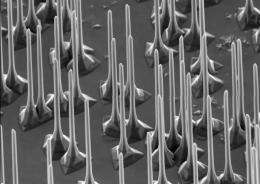Nanotechnology gets a new light touch

(PhysOrg.com) -- Building the super-fast computers of the future has just become much easier thanks to an advance by Australian researchers that lets them grab hold of tiny electronics components and probe their inner structure using only a beam of light.
The discovery moves researchers a step closer to utilising semiconductor nano-wires that will be key components of future integrated devices and circuits.
In a paper published in the journal Applied Physics Letters, a team led by Dr Peter Reece, from the UNSW School of Physics, and colleagues from the Australian National University, report for the first time that such tiny objects can not only be held by "optical tweezers" but simultaneously studied in detail using a second laser beam.
"Optical tweezers work by focussing very intense laser beams that can impart forces onto very small objects and let you physically push them around," says Dr Reece, a UNSW Vice-Chancellor's Postdoctoral Research Fellow.
"Using one laser beam you can grab an object, turn it around and look at it from all angles and put it into an orientation you're interested in. What we've done is bring in a second laser beam to probe the internal structure of the object itself, using photo-luminescence spectroscopy.
"Every nano-wire - and, indeed any nano-scale object - is different and you need to understand these nuances to make practical use of them. This gives us a new tool that we can use to pre-select the components we want.
"The novel part of our work is to look at the light emitted from the nano-wire when it is excited with the second laser beam as the diagnostic tool; it can tell us so much more about the nature and structure of the material. No-one's done this before.
"I'm very interested in building nano-sized devices - it's a big new area of application in science. While our demand for information processing grows unabated, our ability to meet these demands is beginning to waiver.
"The microelectronics industry has reached its limits for providing further levels of large-scale integration of components and, without a change in technology, future computer processor performances will stagnate.
"The optical technologies that revolutionised long-haul communications and brought us high-speed internet may be the key to the future of on-chip information processing. Working with researchers in the UK, we hope we can harness the 'forces of light' to build and test prototype nano-scale optical devices which may one day power your personal computer."
More information: Applied Physics Letters, apl.aip.org/
Provided by University of New South Wales (news : web)


















